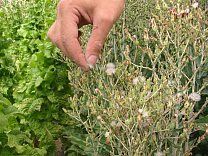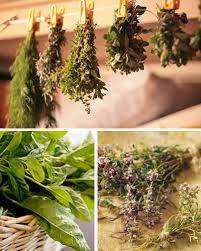
One of the oldest means of preserving food is by drying. This is easy in the warm and dry conditions of the Mediterranean where it is easy to use the sun to take the moisture out of the food. Micro-organisms which cause food to decay cannot survive without moisture and by removing 90% of the water content your fruit, vegetables and herbs can be stored for later use.
Drying food will preserve many of the nutrients and your produce can easily be used after re-hydration, added to soups, casseroles, stews or enjoyed dry. There are a number of methods for drying your produce: by using a food dehydrator, solar drying, air drying or oven drying.
Try to select produce, for drying, which is at its best and cut to an equal size to ensure your produce dry's at a even rate. Most vegetables should be blanched prior to drying to destroy enzymes. Whilst fruit can be dipped in a water mixture with added fruit or lemon juice, pectin, honey or salty water. By dipping the fruit you will prevent oxidisation which darkens the fruit.
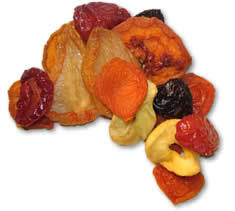
Your fruit is generally dry enough when it is soft and leathery and vegetables are dry enough when they become crisp. Once dried, it is important to properly store your produce. Store in tightly closed jars and whenever possible fill these completely to keep the air out. Jars should be kept in a cool, dry and dark place and the produced used within 6 months. Dried fruits can be eaten dry and beans can be re-hydrated over night in water. To rehydrate other produce, simply pour over boiling water and allow to stand for a few minutes to a few hours depending on the produce or simply add dry to soups, casseroles or stews.
Methods of Drying
Food Dehydrator - is an appliance which uses heat and airflow to remove the moisture from the food. The price of an appliance can range from about 60EUR to 300EUR and is generally higher for larger capacity appliances. Before buying an appliance consider how much usage it will get, its electricity consumption and what size meets your needs.
 Solar Drying
Solar Drying - given the Mediterranean climate this is the most efficient and cost effective way of drying produce. Simply place your produce in single layers on non-stick racks, which allow full air flow, cover with netting to keep out insects and place in the sun daily until thoroughly dried. Drying can take from between 2-4 days depending on the daily temperature. Bring your racks in at night to stop dew forming on your drying produce. When nearly dry, move to the shade to complete drying and to avoid scorching. After sun drying, and to ensure all insects are destroyed, it is recommended that you freeze your produce for three days.
Alternatively, you can shorten the drying time by making a solar drier. I would recommend you research a design which suits your needs, there are numerous designs available and many use recycled materials or can be made using cardboard boxes.
Air Drying - This is a very easy method and suitable for herbs. And it is very useful to have dried herbs available in the kitchen for herbs used regularly like mint, parsley and oregano. Pick your herbs and remove any withered, damaged or dead leaves. Gather together your herbs in bunches, tie at the stem and blanch in boiling water for a few seconds to remove any dirt or insects. Shake and leave to dry before hanging in a dry breezy place such as by a kitchen window. Drying normally takes two to three days. When dry crush the herbs, remove the stalks and store in an airtight jar in a dark and cool place.
Oven Drying - if you encounter a period without sufficiently high temperatures to sun dry this is a simple drying method. Place your produce, in single layers, on non-stick trays, or straight on the oven racks if large enough, and dry at 50c to 60c for between 4 to 10 hours. Regularly check for dryness and turn your produce to ensure even drying.
 Vegetable Drying Guide
Vegetable Drying Guide - With the exception of onions and peppers, which should just be washed, wash and blanch all vegetables before drying. The following drying times are a guide and will vary depending on the drying temperatures and drying method used.
All types of beans - Stem and cut into 2.5cm pieces, blanch and dry for 6-8 hours
Beetroot - Cook, peel, cut into 8mm chunks and dry for 3-6 hours
Broccoli - Cut and dry for 3-6 hours
Carrots - Peel, slice and dry for 6-8 hours
Cauliflower - Cut and dry for 6-10 hours
Courgettes - Slice thinly and dry for 4-8 hours
Onions - Peel, slice 8mm thick and dry for 6-8 hours
Peas - Pod and dry for 6-10 hours
Peppers - De-seed, cut into uniform sizes and dry for 4-8 hours
Potatoes - Peel, slice thinly and dry for 6-10 hours
Sweetcorn - Remove from cob, blanch and dry for 6-10 hours
Tomatoes - Dip in boiling water and remove skins, slice and dry for 6-10 hours
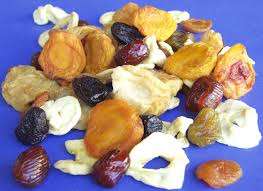 Fruit Drying Guide
Fruit Drying Guide - select fruit which is blemish free and ripe but not over ripe. All fruit should be washed, pitted and sliced. Fruit can be soaked in a watered down solution with added lemon juice, pectin, fruit juice or honey for 5 minutes, prior to drying, which while help preserve its colour. The drying times are provided for guidance but will vary depending on the drying temperature and drying method used.
Apples - Peel, core, cut into thin rings. Blanch for 5 minutes and dry for 6-8 hours
Apricots - Cut in half and turn inside out . Blanch for 5 minutes and dry for 8-12 hours
Peaches - Peel, halve or quarter and dry for 6 - 15 hours
Pears - Peel, slice thinly and dry for 6-15 hours
Soft Fruits - Dry for 8-15 hours
Strawberries - Cut in half and dry for 6-12 hours

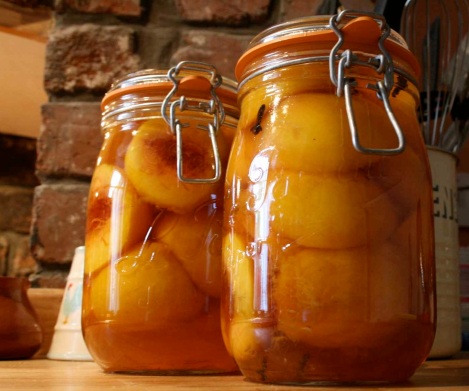 Bottling is a very
Bottling is a very  Vegetables harvested for storage should be thoroughly cleaned. Potatoes, sweet potatoes and Jerusalem Artichokes are best left in the soil until needed. Onions and garlic can be tied in bunches and hung in a dry airy position. Many legumes can be left to dry on the plant and the beans podded for storage when completely dry. Marrows, pumpkins and melons should be stored on shelving under cover in a dry and airy position.
Vegetables harvested for storage should be thoroughly cleaned. Potatoes, sweet potatoes and Jerusalem Artichokes are best left in the soil until needed. Onions and garlic can be tied in bunches and hung in a dry airy position. Many legumes can be left to dry on the plant and the beans podded for storage when completely dry. Marrows, pumpkins and melons should be stored on shelving under cover in a dry and airy position. 